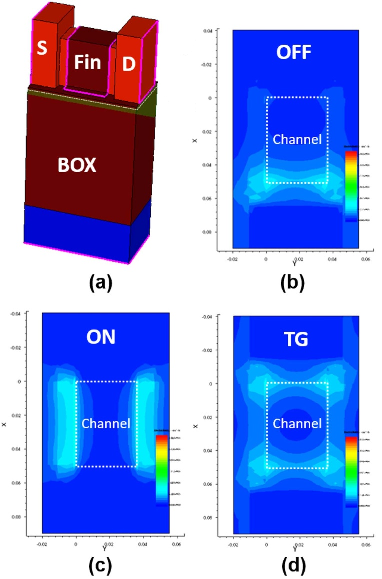Bias and geometry dependence of total-ionizing-dose effects in SOI FinFETs
Zhexuan Ren1, Xia An1, Gensong Li1, Runsheng Wang1, Nuo Xu2, Xing Zhang1 and Ru Huang1
1Institute of Microelectronics, Peking University, Beijing 100871, CN
2Department of Electrical Engineering and Computer Sciences, UCB, CA 94720, USA
Semiconductor Science and Technology, Volume 35, Number 7
Abstract: In this paper, a systematic research on the total-ionizing-dose (TID) effects of NMOS and PMOS silicon-on-insulator (SOI) FinFETs is performed experimentally. The bias and geometry dependence of TID effects are analysed. The experimental results show that the threshold voltage (Vth) shift occurs in SOI FinFETs after x-ray irradiation. After 1 Mrad (Si) irradiation, the maximum Vth shift is about 40 mV. The 'worst case' irradiation bias conditions for NMOS and PMOS are TG and ON states, respectively, which induces the largest Vth shift after irradiation. The 3D TCAD simulation is carried out to further analyse the bias dependence results. Simulation results highlight the difference in electric field distribution in the buried oxide under different bias configurations, which leads to different distribution of irradiation-induced trapped charges. Finally, clear geometry dependence is observed in the TID experiment. Both NMOS and PMOS devices with larger fin width and/or smaller gate length are more sensitive to TID irradiation. The results deepen the understanding of the TID effect of SOI FinFETs and provide important technical support for the radiation-hardened research of FinFET technology.
Figure: (a) SOI NMOS FinFET in 3D TCAD software with Z-cut in BOX layer. Simulated electric field distribution in Z-cut plane for OFF (b), ON (c) and TG (d) bias conditions. The white dashed box in figure (b), (c), (d) indicates the relative position of the channel region.
Acknowledgments: This work was supported in part by the National Natural Science Foundation of China (No.61421005, 61434007) and 111 Project (B18001). The authors would like to thank the staff of the Xinjiang Technical Institute of Physics and Chemistry (XTIPC), Chinese Academy of Sciences (CAS) for their assistance in the TID irradiation experiment.

